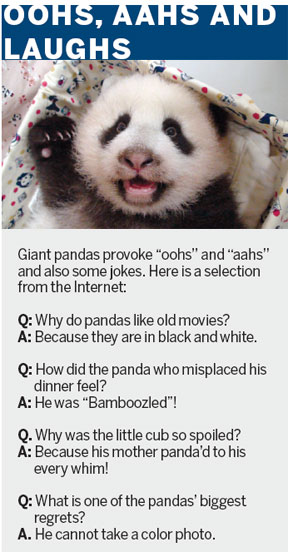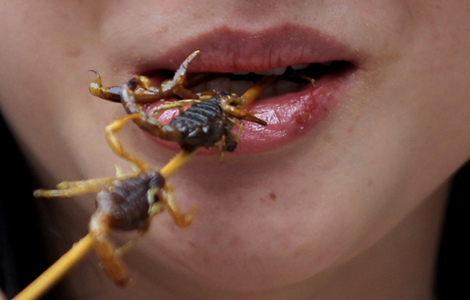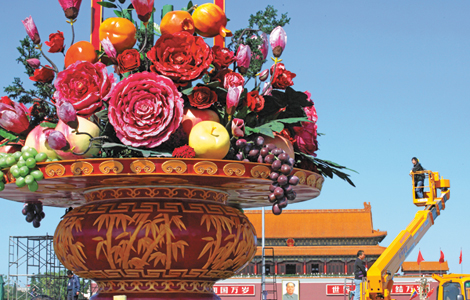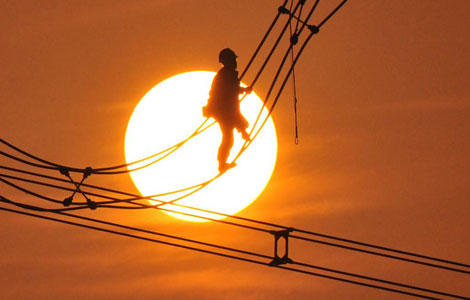It's been a panda-ful year
Updated: 2013-10-04 09:10
By Amy He (China Daily)
|
||||||||
Many cubs
Meanwhile, the panda lineage forges ahead, with 2013 so far being a good one for panda births.
Mom Haizi gave birth to twin cubs in Sichuan in June, the first pair to be born this year. A pair of pandas presented to Taiwan in 2008 gave birth to a female cub in early July. Nicknamed Yuan Zai, the cub is the first born to parents Yuan Yuan and Tuan Tuan, who were given to Taiwan by the mainland as goodwill gifts.
Yang Yang and Long Hui became parents to a male baby panda at Zoo Vienna, which was born by natural conception and only the third ever in Europe. About 10 days later, Mei Xiang, a 15-year-old panda at the Smithsonian National Zoo in Washington, gave birth to a female cub.
A cub born in Madrid at the end of August - also male - was conceived through artificial insemination, just like the twins born to Lun Lun at Zoo Atlanta in Georgia, the first panda twins to survive in the US.
Breeding pandas has always been a difficult task for scientists since the fertility period for a female panda is only a couple of days annually, which makes the successful births from this year ever the more reassuring.
"One of the big problems [we faced] when we initiated our conservation program was a very low success rate for captive breeding, both in terms of successful breeding and in the successful rearing of cubs," said Owen of the San Diego Zoo in California, which last saw a panda birth in 2012.
Understanding how pandas communicate is a key to understanding how they breed, and that involves monitoring pandas' well-being, Owen said. Like any other species, animals in captivity do best when they are behaving as they would in a natural environment. To assess whether that behavior is normal, Owen said that it is important to observe how the animals engage with their environment.
"Enrichment," Owen said, is a specific type of strategy in which species are provided with positive challenges that keep the animals stimulated, whether cognitively or physically.
"There needs to be a degree of novelty in the approach as well, so that the animal doesn't get the same enrichment item every day to the point where it's no longer an interesting or novel thing for them to interact with," she said.
Panda specialists do a lot to keep pandas happy and stimulated in captivity, and extensively catalogue fluctuations that might occur in a panda's stress or well-being levels. But as it turns out, pandas don't have many problems breeding in the wild without human aid. Authors Zhang and Bexell call them "stoic survivors" and wrote in their book that they are "extremely adept breeders".
Breeding problems
What is giving pandas trouble is breeding in captivity, which has led to extensive efforts in artificial insemination. At the San Diego Zoo, artificial insemination was initially used when a pair of pandas that went to the zoo in 1996 proved to be sexually incompatible, Owen said.
"The male was completely uninterested in breeding with our female, so we used artificial insemination prior to the arrival in 2003 of our current male, Gao Gao, and we had a successful artificial insemination," Owen said.
Artificial insemination techniques are constantly being fine-tuned, and the key to success, Owen said, is understanding the timing.
The reproductive physiology department at the San Diego Zoo has worked on developing techniques to preserve the semen that's collected from the male pandas. Other zoos in the US - the National Zoo, Zoo Atlanta, the Memphis Zoo in Tennessee - have been actively involved, which has led to other successes this year, said Owen.
Many consider the bears to be China's national treasure, and their frequent use in international diplomatic relations helped coin the phrase "panda diplomacy". The animals were used as gifts in diplomatic exchanges, although gifting pandas has turned into a practice of placing the bears on loan for a period of up to 10 years.
It costs up to $1,000,000 a year to get a panda on loan, and any cubs born to the pandas are property of the Chinese government. The pandas are usually required to go back to China at around age 3, San Diego Zoo's Owen said, but that can vary.
Good business

The costs are hefty, but plenty of zoos overseas are willing to pay the money because pandas are good business.
Jeff Wallace, a professor of economics at the University of Memphis, told BBC Radio earlier in September that pandas at the Memphis Zoo generated upwards of $20 million a year for the zoo and the local economy.
"When you think about it, people come to the zoo or come to Memphis specifically to see the pandas at the zoo," he said. "It's a giant magnet in terms of tourism, and when these people come to Memphis to see the pandas, they're also spending money in the nightclubs, they're visiting restaurants, and leaving lots of money behind."
Research gathered by the Association of Zoos and Aquariums (AZA) showed that AZA-accredited zoos and aquariums - which includes the Memphis Zoo - generated $158 million in economic activity for Tennessee in 2011. According to Wallace's estimates, that means that for Tennessee, the black and white bears generated one-eighth of that total, through their sheer attractiveness of being cute.
The Edinburgh Zoo in Scotland saw its annual income jump 53 percent to almost 15 million ($24 million) after the arrival of pandas Tian Tian and Yang Guang in December 2011.
In a 2012 financial statement released by the owners of the zoo, CEO Chris West said that in a year, the zoo went from an operating deficit to a surplus of 1.5 million ($2.4 million). This was "obviously a huge leap for us, we must acknowledge giant pandas as being part of the reason".
The lines to see pandas can be long, but given their rarity in zoos, the anticipation can be great and this lends itself to great marketing opportunities through merchandise and branding.
The Edinburgh Zoo trademarked the pandas' anglicized names (Sweetie and Sunshine) before the bears even arrived at the zoo, making sure that if the pandas were to give birth, it won't inspire other businesses to make money off the pandas' branding for the Edinburgh Zoo, according to The Guardian newspaper. Ned Potter wrote for ABCNews.com: "Zoos know they can draw visitors, attract corporate donations, and even build a national identity just by showcasing one unique species. And pandas are perfect for that - they're cute, cuddly, and instantly recognizable."
The bears' endearment to people is explained by authors Zhang and Bexell in Giant Pandas.
They note the zoology concept of "neoteny", which is particularly applicable to pandas and people's perceptions of them. Neoteny is the "retention of ostensibly immature characteristics in adulthood. These characters include a bulging forehead, round cheeks, big eyes, short stubby limbs and the appearance of a chubby body".
These physical characteristics alone are cute to people, but there are also the panda's neotenic behaviors as well, which include playfulness, "clumsiness (in the case of pandas, assume clumsiness) and a perceived peaceful, happy-go-lucky personality".
With these traits, it's not surprising that thousands crowd into zoos just to get a glimpse, despite pandas spending most of their time eating, sleeping and lulling around. Different zoos' panda cams regularly broadcast their panda's activities across the web.
Recently, viewers got a glimpse of Mei Xiang giving birth on Aug 23 at the National Zoo in Washington, drawing so many visits that the servers hosting the camera online crashed. The zoo has experienced 1.2 million clicks to the panda cam since the birth. The camera draws so much traffic that users get kicked off after hitting a 15-minute viewing limit.
"I don't think there's a person on the planet who can look at a giant panda and not say that they are incredibly beautiful and cute animals," Owen said. "We need to make those connections for the people we have the opportunity to communicate with, and one of the first ways to open people's eyes to what they can do to impact in a positive way the conservation status of wildlife is to open their hearts.
"And pandas are really good at that."
Contact the writer at amyhe@chinadailyusa.com
(China Daily USA 10/04/2013 page19)

 Driver shot dead in car chase at US Capitol
Driver shot dead in car chase at US Capitol
 NY SUV driver's wife: We were in 'grave danger'
NY SUV driver's wife: We were in 'grave danger'
 Death toll in sunk boat off Italy could top 200
Death toll in sunk boat off Italy could top 200
 A southern staple
A southern staple
 Tropical Storm Karen aims for US Gulf Coast
Tropical Storm Karen aims for US Gulf Coast
 City rush, island time
City rush, island time
 Death toll in Italy migrant boat wreck rises to 94
Death toll in Italy migrant boat wreck rises to 94
 Lang Lang: First Chinese winner of Classic Brits Award
Lang Lang: First Chinese winner of Classic Brits Award
Most Viewed
Editor's Picks

|

|

|

|

|

|
Today's Top News
Obama cancels APEC trip due to gov't shutdown
US hints Iran could get some sanctions relief
Twitter unveils IPO filing, aims to raise $1 b
Hundreds dead as boat sinks off Italy
Gunfire forces brief lockdown at US Capitol
NY driver's wife says in danger
Call for new 'maritime silk road'
Shutdown in third day
US Weekly

|

|






